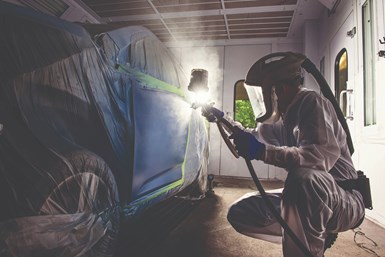The Positive (and Negative) On Airflow
Jeremy Winters of Accudraft Paint Booths shares how solvent and water-based coatings are affected by a paint booth’s airflow.
#asktheexpert

Q: What advice do you have for dialing in the correct amount of airflow for drying painted parts?
A: When you hear people talking about airflow these days, many times it’s directed at the much-needed air volume to dry today’s waterborne coatings. Unlike when solvent paints were king, you didn’t need massive amounts of air to dry paint. In fact, too much airflow would cause issues. But what do these two time periods have in common when it comes to cubic feet per minute (CFM)? Both are affected and have similar issues with too much and too little air. Older booths didn’t have the technology available today where we can now control airspeed at a push of a button or a tap of a screen. In those days, the thought of waterborne coatings being as prevalent as they are today wasn’t even in a painter’s head. But we learned early on that a paint booth needs two things: enough air to evacuate the solvents, but not so much airflow to skim the surface. As a seasoned painter, I can tell you with confidence that water is much more forgiving and faster for collision repairs. For the painters that have been using solvent for years, I can completely understand not wanting to change, as I was one of them originally. But let’s dive into the why and how of air movement and try to explain the reasons.
Featured Content
If you run too much air across the surface of solvent-based coatings, you run the risk of the surface skimming over, effectively trapping solvent under a layer of semi-dried paint. The problem here is that the solvents force themselves to the top one way or another and it’s never a pretty sight when it happens. This is the same effect for pounding on too much clear coat, base, and yes, even primer coatings. For these reasons, I’m not a fan of using blowers to dry solvent-coated jobs in a booth. Solvent needs airflow, temperature, and the correct temperature reducer to dry correctly. Too many times, I have seen other painters doing this, only to then clear a vehicle and have it solvent pop or come back a few weeks later. The problem that arises with it being in the base is now you have a wet solvent unable to escape under a catalyzed clear. When the solvents effectively work their way to the top, you’re dealing with delamination issues.
Quite the opposite are waterborne products. While heat certainly helps expedite the process, the main source for drying water is air movement. The product has to be dehydrated or, just like with solvent systems that haven’t dried, you will be left with a wet film. I believe any collision painter knows exactly what it is like to finish spraying a water base coat on a vehicle, only to have walked out and forgotten to turn the fans or heat on. Coming back a few minutes later, the panel is still completely wet, exactly like it was left.
The key difference in solvent vs water coatings is solvent is ready to spray based on temperature, and water is ready to spray based on relative humidity. The easiest way to dry water is with air movement, and it dries faster with the inclusion of heat to help dehydrate the panel. Air moving across a panel dries the panel faster than air going directly at a panel. A demonstration at a local PPG school in Atlanta taught me the importance of directional air when drying basecoat. We painted a front clip that all centers have and then the instructor dried my side, and I dried his side so there would be nothing to be said about application. After just minutes, we put a piece of 1.5" tape across a part of each side and pulled, only to find that I hadn’t dried mine enough, which left quite the mess, and his came off clean. It completely changed the way I looked at air movement and drying.
This is why we at Accudraft have control panels that help the end painter choose what’s best for their jobs. Our SMART Pad comes preprogrammed with two settings. Program One has slower air movement for solvent-based painting and Program Two has a faster air speed for water paints. However, we all know that no two paints are the same and application varies from product to product. Take for example Axalta water lines like Cromax Pro, Hi-Tech, and Standoblue, which spray completely differently from any other products on the market. Not to mention every painter sprays differently and has their own preferences. This is one of the benefits of our FOCUS panel which allows the user to set up to 999 individual programs with their preferences for ease of use and swapping products. No matter the situation, the old saying holds true: Take your time and do it right the first time. Slower is always faster at the end of the day.
About the Author

Jeremy Winters
Jeremy Winters is a marketing and content creator for Accudraft Paint Booths. Visit accudraftpaintbooths.com.
RELATED CONTENT
-
Plating with Zinc-Nickel: Benefits and Challenges
Chad Murphy of Columbia Chemical speaks about the benefits of various types of zinc-nickel alloy, and provides tips for manufacturers about the zinc-nickel plating process.
-
Developments and Trends in Powder Coating
New solutions for powder coating centers combine powder preparation, conveyance, dosing and color changes into a fully automated, closed system.
-
Automate Your Brush Plating Operation
Derek Kilgore from Sifco ASC says the brush plating operation can be mechanized, semi-automated or even fully automated.


















